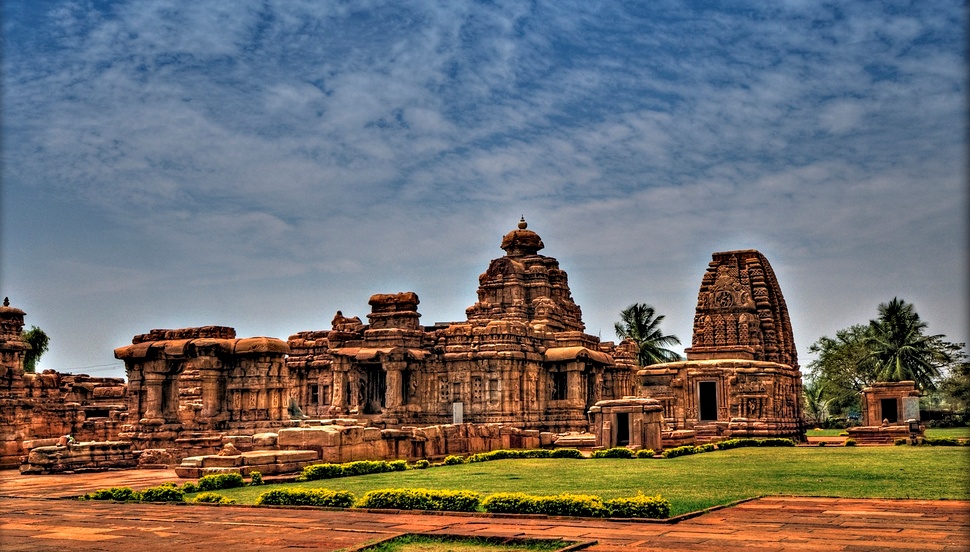Pattadakal group of temple, Karnataka

Address
Pattadakal group of temple, Bagalkot district, Karnataka 587201, India
Diety
Shiva
Introduction
Pattadakal, also called Raktapura, is a complex of 7th and 8th century CE Hindu and Jain temples in northern Karnataka, India. Located on the west bank of the Malaprabha River in Bagalkot district, this UNESCO World Heritage Site is 23 kilometres (14 mi) from Badami and about 9.7 kilometres (6 mi) from Aihole, both of which are historically significant centres of Chalukya monuments. The monument is a protected site under Indian law and is managed by the Archaeological Survey of India (ASI).
Puranic Significance
Pattadakal, which means “place of coronation,” held immense cultural and historical significance in ancient India. It was considered a holy place as it marked the point where the Malaprabha River changed its course northwards towards the Himalayas and the Kailasha mountain. As the name suggests, it was frequently used during the Chalukya dynasty for coronation ceremonies, including that of Vinayaditya in the 7th century CE. “Pattada-Kisuvolal” roughly translates to “red soil valley for coronation.” Pattadakal, along with its neighboring sites Aihole and Badami, served as a major cultural and religious center. It was a hub for architectural innovations and the experimentation of ideas. This cultural melting pot in the 7th century became a nexus where ideas from both northern and southern India fused.
The Chalukya Empire, during this period, constructed many temples in the Aihole-Badami-Pattadakal region. Following the decline of the Chalukya Empire, the Rashtrakuta kingdom ruled over the region into the 10th century. In the 11th and 12th centuries, the Late Chalukyas, an offshoot of the Early Chalukya Empire, continued to build new Hindu, Jain, and Buddhist temples and monasteries in the Pattadakal region. However, the 13th century brought challenges to Pattadakal. The region, including the Malaprabha valley, faced raids and plunder by the armies of the Delhi Sultanate, leading to devastation in the area. This period of turmoil ended with the rise of the Vijayanagara Empire, which took measures to protect the monuments, including constructing forts for their defense. Pattadakal was situated on the border region and witnessed conflicts between Vijayanagara and the Sultanates to its north. The monuments at Pattadakal stand as a testament to the historical interaction between the early northern and southern styles of Hindu art, showcasing the rich cultural heritage of India through the ages.
Special Features
Pattadakal boasts ten major temples, consisting of nine Hindu temples and one Jain temple. These temples, along with numerous small shrines and plinths, form an impressive architectural complex. Here are the names of the major temples:
Hindu Temples:
- Virupaksha Temple
- Kadasiddeshwara Temple
- Jambulingeshwara Temple
- Galaganatha Temple
- Chandrashekhara Temple
- Sangameshwara Temple
- Kashi Vishwanatha Temple
- Mallikarjuna Temple
- Papanatha Temple
Jain Temple:
- Jain Narayana Temple
These temples are primarily dedicated to Lord Shiva, and they are situated along the banks of the Malaprabha River. The temples are connected by a walkway, making it convenient for visitors to explore them. The architectural styles of these temples reflect a fusion of two major Indian architectural traditions, one from northern India and the other from the southern region.
The Jain Narayana Temple, as the name suggests, is a Jain temple and is located about a kilometer to the west of the main cluster of Hindu temples. Pattadakal’s temples are not only architectural marvels but also important religious and cultural sites that showcase the rich heritage of India.
Century/Period/Age
7th century CE
Managed By
UNESCO World Heritage site
Nearest Bus Station
Badami
Nearest Railway Station
Badami
Nearest Airport
Belgaum




